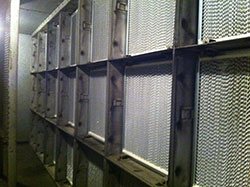view all Case Studies
Bryan Medical Center Simplifies Onsite Power Operation

Bryan Medical Center’s East Campus in Lincoln, Neb., needed to simplify its emergency power testing procedures and produce automated Joint Commission-quality reports more efficiently.
November 6, 2013 -
Power & Communication
Bryan Medical Center’s East Campus in Lincoln, Neb., needed to simplify its emergency power testing procedures and produce automated Joint Commission-quality reports more efficiently. The hospital has a 4,000 kW emergency power system that supports nearly all operations spanning the center’s 1.075 million square feet of floor space. Facilities include a 382-bed hospital and five other facilities, including an office building, obstetrics tower, and a 700-student college.
To meet its power testing and reporting needs, the hospital uses Emerson Network Power’s ASCO PowerQuest power monitoring and control system to instantly gather, process, analyze, and act on the huge volumes and velocity of data that the medical center’s critical power management system (CPMS) generates, including the center’s 37 ASCO automatic transfer switches. The ASCO power monitoring and control system enables the center to test its entire, decentralized six gen-set emergency power system from a single computer screen.
The system monitors actual load on the generators, which aren’t paralleled, during tests. The system displays the exact percentage of a gen-set’s nameplate kW rating that is under load to tell at a glance when a test meets the Joint Commission’s 30 percent of nameplate load requirement for a given amount of time. Nameplate rating is only one of a host of data points that are monitored to give operators a granular understanding of system operation. The system also helps trend gen-set load growth so the hospital knows how much load can be added to a given gen-set during a facility remodeling or expansion.
The system generates automatic alarms and notifications via cell phone, tablet, and other devices. Other capabilities include the ability to operate the system from up to 10 client computers, view historical event logs, power readings, and overall system operation at a glance, and change power transfer switch settings from the software. The system can remotely connect to the power system through the Internet to perform software upgrades and diagnostics.
Piggybacking on the medical center’s existing VLAN Ethernet network minimized installation time and avoided the labor and materials costs of running a secondary, RS485 twisted pair communications structure.
Next
Read next on FacilitiesNet












